2023.03.23
CULTUREWays of Life, Figures of Youth, and Regional Diversity . . .
Acquiring Deeper Understanding of Different Cultures through Books
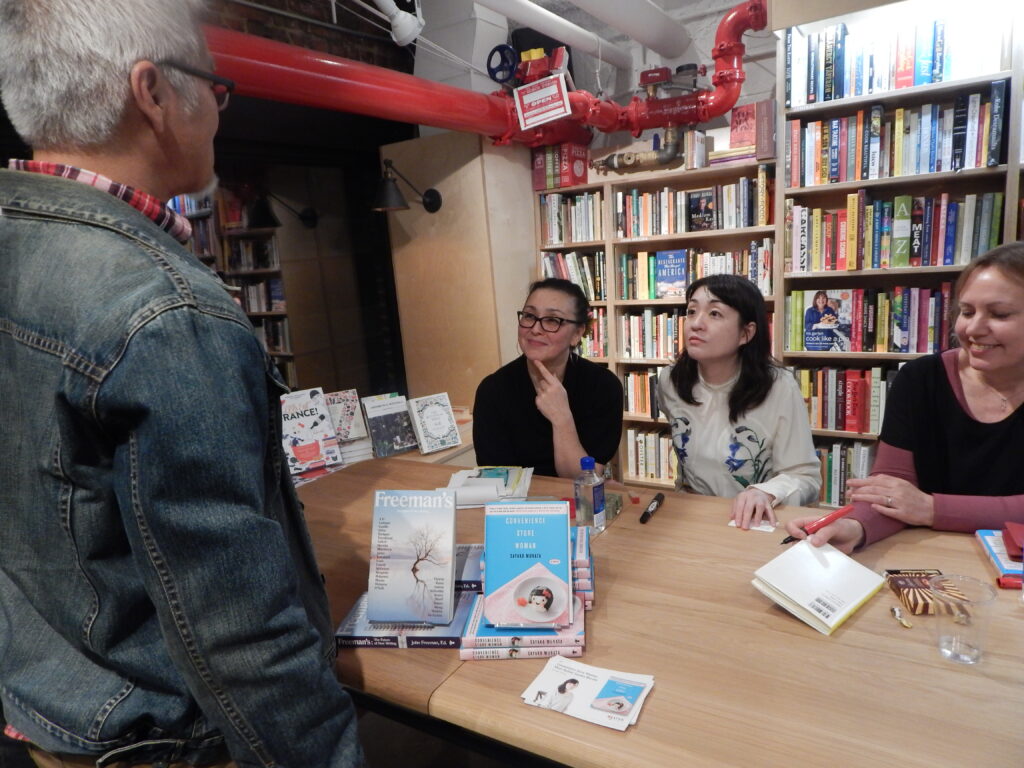
In November 2018, author MURATA Sayaka visited a bookstore in Brooklyn, New York, as part of a traveling lecture series in North America organized by The Japan Foundation. Murata, right-side center in the photo, is chatting with readers after the event. On the right is translator Ginny Tapley Takemori.
Literature is a sophisticated form of creation using language. The process of translating, publishing, and disseminating literary works worldwide involves the dedication of and interactions among many different people. Through books, different cultures and values intersect. The Japan Foundation supports such opportunities.
“Irasshaimasé.”
This greeting is commonly used in Japan by shopkeepers to welcome customers. Ginny Tapley Takemori, who translated MURATA Sayaka’s best-selling novel “Convenience Store Woman” into English, shares the difficulty she faced in translating irasshaimasé, which is uttered multiple times in this work. The English word “welcome” is unnatural, and replacing it with “hello” does not work. After much deliberation, Takemori decided to use this uniquely Japanese expression for customer service in romanized spelling, irasshaimasé.
Seemingly casual words can carry nuances of the culture and values of the language and its people, making them difficult to translate. Therefore, translators read deeply into the work, exploring its background and examining each word as they work. The resulting translated book allows the reader to also experience the culture in which this work was created.
The Four Stages of Interaction that Arise in the Translation and Publication Process
People often encounter foreign novels that trigger an interest in getting to know peoples and cultures abroad. When Japanese books are read around the world, the same can occur; Japanese culture is widely disseminated, which can form the basis for international exchanges. The Japan Foundation (JF) has been promoting international exchanges through books starting from its early days.
One example of such efforts is the JF Support Program for Translation and Publication. In 1974, soon after its establishment, JF began to support foreign publishers that publish books about Japan or translate and publish books written in Japanese and has continued to do so ever since. Such support has resulted in a total of approximately 1,500 books being translated into more than 50 languages, in nearly 80 countries and regions, representing a wide variety of genres. In the past, the majority of the featured works fell into the categories of classic and academic literature, but in recent years, the number of contemporary literature is on the rise.
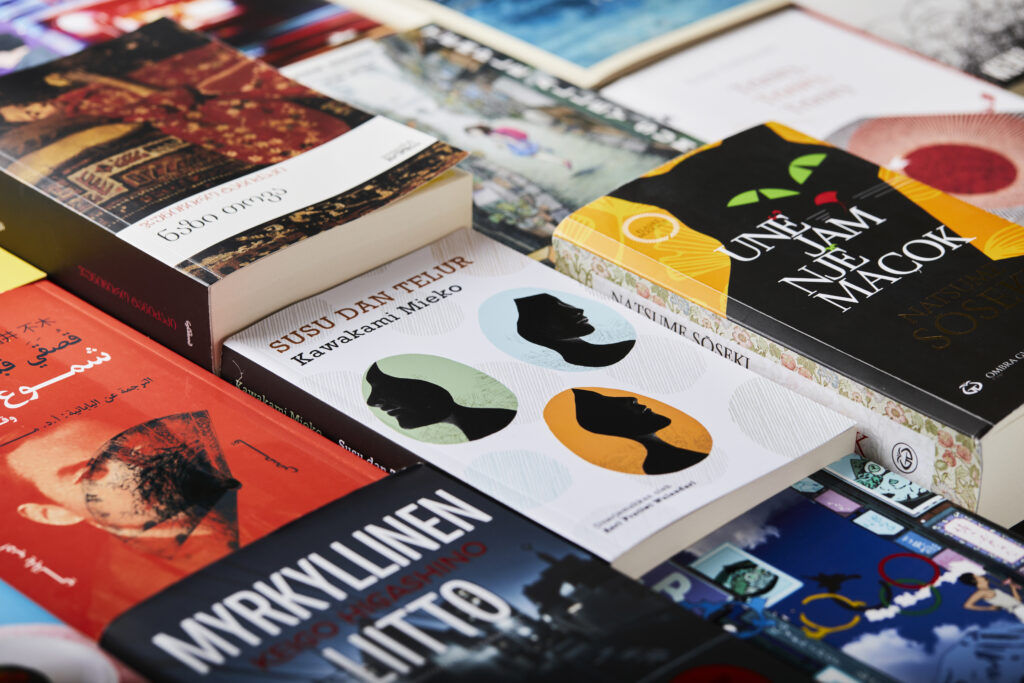
Books translated and published with the support of JF. (from the top left to the bottom right) “The Makioka Sisters” by TANIZAKI Junichiro (Georgian version) published by Diogene Publishers; “Temple Alley Summer” by KASHIWABA Sachiko (English version) published by Restless Books; “Trinity, Trinity, Trinity” by KOBAYASHI Erika (French version) published by Éditions Dalva; “Body Candles and Other Stories” by KOSAKAI Fuboku (Arabic version) published by Mahrousa for publishing, information & Press Service; “Breasts and Eggs” by KAWAKAMI Mieko (Indonesian version) published by Moooi Pustaka; “I Am a Cat” by NATSUME Soseki (Albanian version) published by Ombra GVG; “Salvation of a Saint” by HIGASHINO Keigo (Finnish version) published by Kustantamo Punainen Silakka; “Tokyo Ueno Station” by YU Miri (Italian version) published by 21lettere. Photo: Yuta Hinohara
Professor NUMANO Mitsuyoshi, a leading scholar of Slavic literature and professor emeritus at the University of Tokyo who also possesses a deep knowledge of Japanese literature, commented on the publication of translations, stating that “First there are excellent books that should be translated, and then there are translators who want to translate them. There are publishers who want to publish them, and there are readers who want to read them. Translation and publication of books are only possible when the original author, the translator, the publisher, and the readers are all present. And at each of those four stages, various interactions are born.”
From 1993 to 2016, JF published a regular English newsletter, “Japanese Book News,” that contained information on new publications in Japan, aimed primarily at foreign publishers and translators. From 2012 to 2017, JF produced five issues of the booklet “Worth Sharing-A Selection of Japanese Books Recommended for Translation,” recommending a total of 100 books for translation and publication abroad, and in 2022, added a special issue introducing 59 Japanese children’s books. “Worth Sharing” is unique in that it presents and selects books based on themes such as “Japan’s Youth,” “Japan’s Regions” and “Japan’s Love,” with the intent of portraying a picture of contemporary Japan with its book choices. Prof. Numano, who was also a book selection committee member, explained, “We felt that shedding light on various aspects of the country can provide an understanding of Japan. It was based on this perspective that we decided on these five themes.”
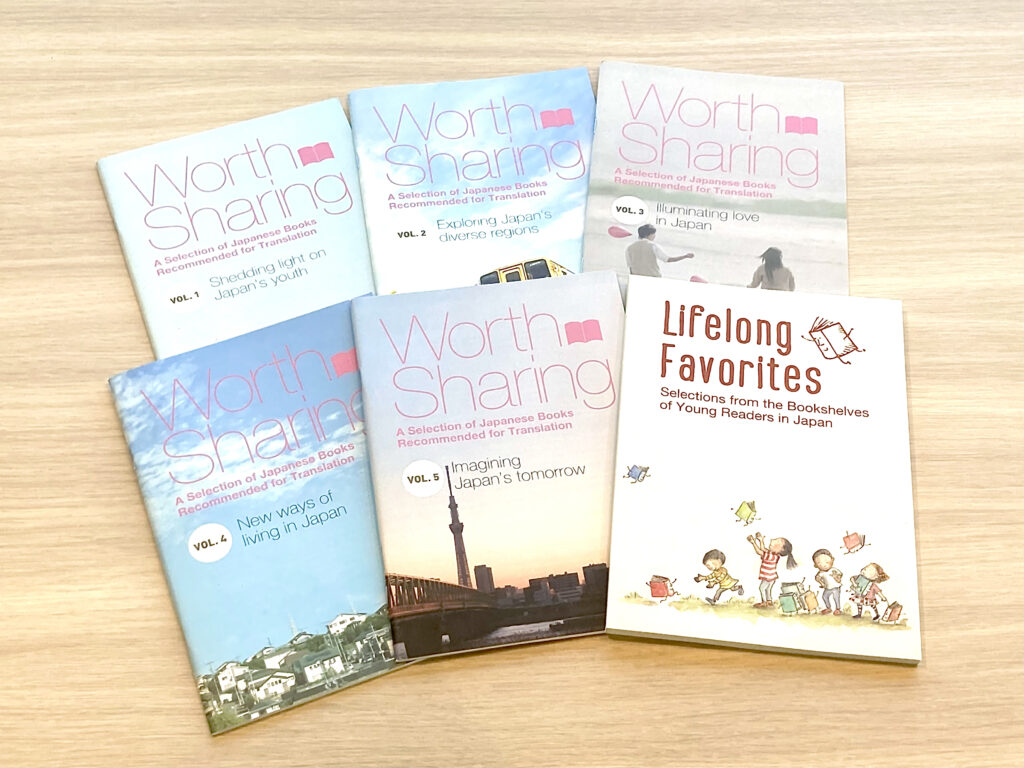
The booklet “Worth Sharing” introduced 20 Japanese books per issue. In 2022, its children’s book edition, “Lifelong Favorites,” was published.
Moreover, JF has also been directly involved in translating and publishing Japanese literature. The anthology series of contemporary Japanese literature in Russian is a prime example. A total of six volumes were published by Inostranka Publishers in Moscow between 2001 and 2005. Prof. Numano and Mr. Grigory Chkhartishvili, a Russian scholar of Japanese literature and a translator, also known as the popular mystery writer Boris Akunin, were both supervising editors on this series that compiled a wide genre of contemporary Japanese literature. “I insist on the contemporary because I believe that true interaction can happen only when we learn about the current reality of a culture. In Russia, before our series, the introduction of Japanese literature had been quite popular, with classics such as The Tale of Genji and The Kokin Wakashu (Collection of Ancient and Modern Japanese Poems) already translated. On the other hand, contemporary Japanese literature was not being widely read. This is why we created these books that compile short stories written by relatively young authors active in the 1980s and the 90s,” says Prof. Numano. This series was made possible by Japan-Russia collaboration from planning to publication, and its first volume, “New Japanese Prose ‘He’ and ‘She,’” nearly sold out its 5,000 commercial copies in a matter of a few months. The publication also led to a Japan-Russia literary exchange program, in which three Japanese authors participated in a dialogue with Russian readers, and this event was widely covered by major Russian media.
Outside of “Japan”―Expanding the Writer’s World through Translation
In the book “Convenience Store Woman” by Murata Sayaka, mentioned at the beginning of this article, the translators in each country had their own difficulties in conveying the word irasshaimasé, the unique Japanese business style of konbini (convenience stores), Japanese food such as mentaiko (seasoned fish eggs) and onigiri (rice balls), and so on. However, they seem to have succeeded in capturing the universal appeal of this work. Takemori, the translator of the English version, stated, “I was confident that Sayaka Murata’s work would be accepted in English-speaking countries as well. The appeal of her work is that it shows the world from a different angle. What we consider normal is, in actuality, merely what society allows. I think the readers will notice these things.”
The work, which has now been translated into more than 30 languages, has resonated with readers around the world, with one Armenian reader commenting, “If you change the names of the characters, it’s an Armenian story.” Another reader, from Brazil, asked, “Is Japanese society really so stifling for women? But actually, we experience similar pressure in Brazil as well.”
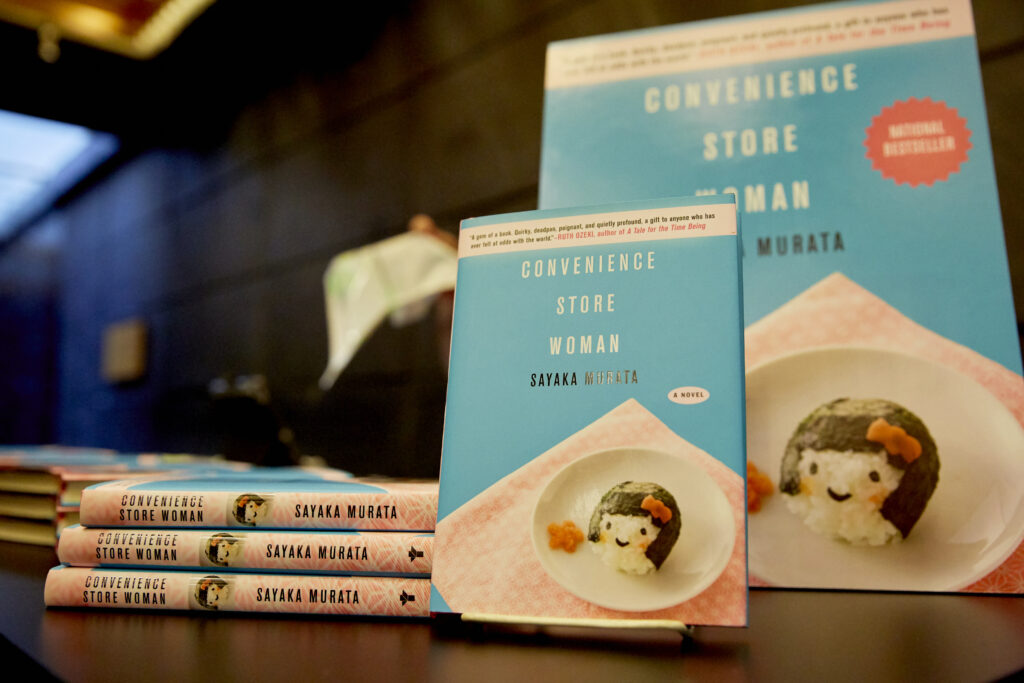
The Japan Foundation, New York, along with Japan Society, co-hosted Ms. Murata’s lecture in New York. The photo shows the English translation (U.S. edition, published by Grove Atlantic) of her “Convenience Store Woman” displayed at the event. Photo: Japan Society ©Daphne Youree
JF has also been providing opportunities for authors to interact with international readers, translators, and publishing professionals. Ms. Murata, who has already experienced many interactions in various countries, said, “I didn‘t consider my book being translated while writing, so I sometimes make new discoveries when I hear feedback [from people overseas] on my work. It was extraordinary and interesting that even in countries I had never been to, my work resonated deeply with the people there. When I attended an event in the U.K., many people told me that they could understand how Keiko, the main character in ‘Convenience Store Woman,’ felt. In the U.S., someone asked me, ‘Do people in Japan really work so diligently?’ Maybe ‘having to work under peer pressure’ appeared very Japanese to this reader. It was wonderful to hear all the different impressions,” she recalls.
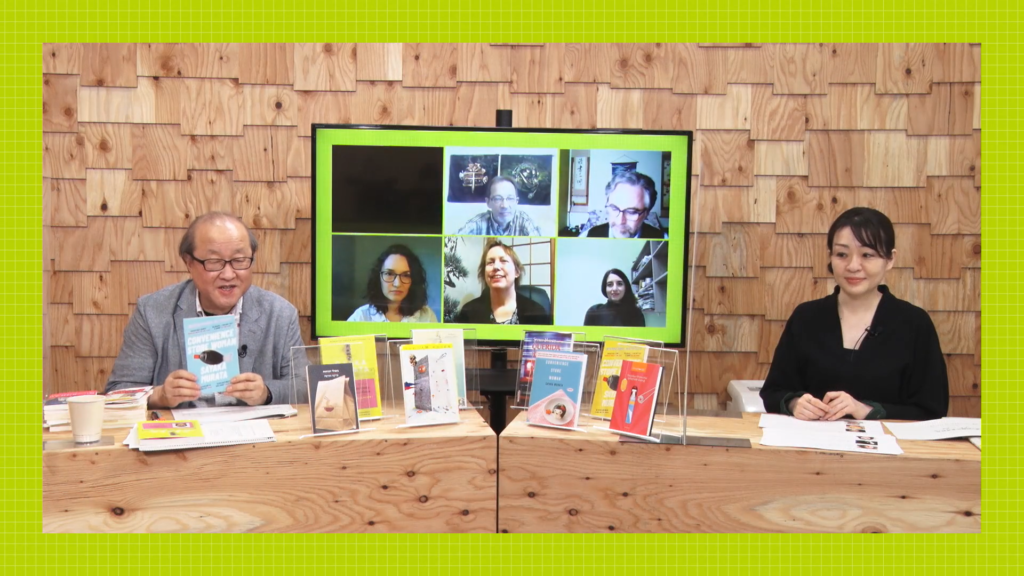
During COVID-19, JF produced and streamed the online translators’ roundtable series “More than Worth Sharing”, in which translators of Japanese literature interacted with each other. In the fifth session, translators of “Convenience Store Woman” from five countries (center of the photo) read the work in their respective languages. They also discussed with Ms. Murata, the author (right), and the roundtable coordinator Prof. Numano (left), the portions of the work that were difficult to translate and the response to the translated version in each country.
What Translation and Publishing Creates
“Before, I only imagined my works being read in Japan. I was taught that ‘a book is a music score and the reader is the performer,’ and recently, I have begun to enjoy imagining that someone from a completely different culture might perform the score that I wrote,” says Ms. Murata. The interactions that occur during the process in which a book is translated and reaches people in various countries, as well as stimulating a reader’s imagination and cross-cultural awareness gained from reading it, can be said to be the international exchange that literature brings. According to Prof. Numano, “Literature is one of humanity’s most sophisticated creations using language. I believe that the act of thoroughly understanding and translating literature written in a foreign language is simultaneously the most difficult and the best form of international exchange.”
A chance encounter with a book can take the reader to a whole new world. JF believes in the power of books.
【Related pages】
Drama, Animation, Documentaries . . .Sharing the Spirit of Japan with the World through TV
Bringing Together Hearts Around the World Through “A Wild Haruki Chase”
In the Footsteps of TEZUKA Osamu, the “Manga Ambassador” Who Continues to Captivate the World with His Outstanding Foresight and Creativity
